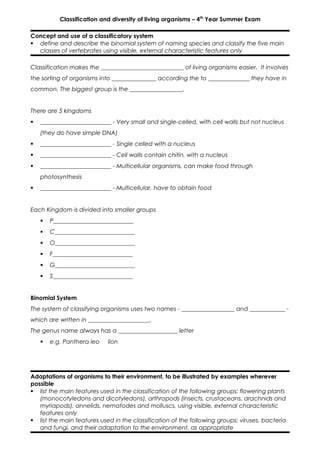
Classification and Diversity in Four Sentences
- 1. Classification and diversity of living organisms – 4th Year Summer Exam Concept and use of a classificatory system define and describe the binomial system of naming species and classify the five main classes of vertebrates using visible, external characteristic features only Classification makes the ____________________________ of living organisms easier. It involves the sorting of organisms into _______________ according the to ______________ they have in common. The biggest group is the __________________. There are 5 kingdoms ________________________ - Very small and single-celled, with cell walls but not nucleus (they do have simple DNA) ________________________ - Single celled with a nucleus ________________________ - Cell walls contain chitin, with a nucleus ________________________ - Multicellular organisms, can make food through photosynthesis ________________________ - Multicellular, have to obtain food Each Kingdom is divided into smaller groups P___________________________ C___________________________ O___________________________ F___________________________ G___________________________ S___________________________ Binomial System The system of classifying organisms uses two names - __________________ and ____________ which are written in _____________________. The genus name always has a ____________________ letter e.g. Panthera leo lion Adaptations of organisms to their environment, to be illustrated by examples wherever possible list the main features used in the classification of the following groups: flowering plants (monocotyledons and dicotyledons), arthropods (insects, crustaceans, arachnids and myriapods), annelids, nematodes and molluscs, using visible, external characteristic features only list the main features used in the classification of the following groups: viruses, bacteria and fungi, and their adaptation to the environment, as appropriate
- 2. Classification of vertebrates vertebrates are animals with a _____________________________ vertebrates are divided into 5 classes Vertebrate class visible external Features Fish Amphibians Reptiles Birds Mammals Classification of Arthropods They are ___________________________ - They have no backbone They have and _______________________ which is waterproof Their bodies are _____________________ They have _________________ limbs Class Example External features Insects Arachnids Crustaceans Myriapods Classification of other groups of invertebrates Class Example Annelids nematodes Molluscs External features
- 3. Classification of viruses, bacteria and fungi Viruses, e.g. HIV Very small NOT ____________________ Contain a strand of DNA or RNA Surrounded by a ________________ _________________ (capsid) Only life process they show is ____________________ (inside host cells) Bacteria e.g. E. coli Small Cell wall, cell membrane and cytoplasm No ___________________, DNA is a single coil Some have a slime capsule Some have ______________ (for movement) Fungi e.g. Mucor Multicellular fungi are composed of ____________________ Cell walls made of cellulose or chitin Do not ___________________________ Some produce spores Classification of flowering plants Key features Multicellular organisms ___________________ cell walls and sap vacuoles Roots, stems and leaves Some cells contain _____________________ Two groups o o Monocotyledons Dicotyledons The term ____________________ means “seed leaf” FEATURE MONOCOTYLEDON DICOTYLEDON In threes In fives Leaf Shape Leaf veins Cotyledons (seed leaf) Grouping of flower parts